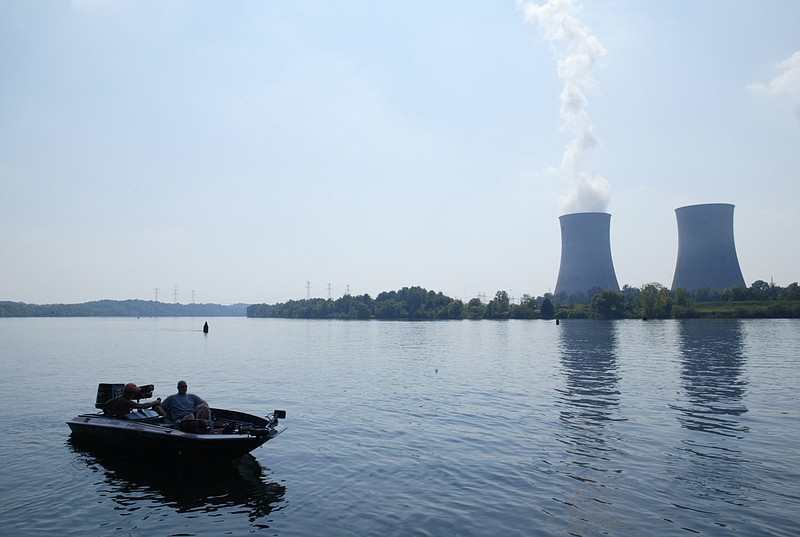Whenever the leaders of TVA, Oak Ridge National Laboratory and the U.S. Department of Energy start talking about partnerships, all of us should itch.
That's especially true when the partnerships involve nuclear energy and bombs - or bomb components. And both of those conversations are going on right now. Break out the calamine lotion.
On Tuesday, the Tennessee Valley Authority, which powered the development of the atomic bomb and other technologies in Oak Ridge to help win World War II, is joining again with Oak Ridge - this time, they say, to fight global warming with, among other things, more nuclear plants. Untried nuclear plants.
And in January, TVA outlined another plan to federal regulators of how it will increase production at Watts Bar Nuclear Plant of tritium, the radioactive isotope of hydrogen needed to turn an atomic bomb into a far more explosive hydrogen bomb.
Try not to scratch.
The tritium matter, which will be decided in coming weeks or months by the Nuclear Regulatory Commission, is not new to TVA or Watts Bar Nuclear Plant. TVA has been making tritium at the plant by irradiating fuel rods there since 2003. In that time, there have been five license amendments to boost tritium production, TVA spokesman Jim Hopson told the Times Free Press in mid-January.
TVA already is loading 1,792 rods during each of its refueling cycles, and the National Nuclear Security Administration, a semi-autonomous agency of the U.S. Department of Energy, wants to raise the number of rods in each cycle to more than 2,400. TVA says such work is part of its national defense mandate and the tritium is used to replenish tritium supplies that decay over time.
But anti-nuclear activists argue that using a civilian nuclear power plant to help make nuclear bomb materials risks putting nuclear weapons into the hands of more countries and terrorists and will put more radioactive tritium into the Tennessee River and Chattanooga's drinking water.
TVA and its nuclear regulator, the U.S. Nuclear Regulatory Commission, monitor radioactive levels in the water and land around Watts Bar, and the amount of tritium and other radioactive materials remain within the commission's acceptable levels, according to the utility.
After TVA irradiates the rods, the NNSA harvests the resulting tritium at the Savannah River Site in Aiken, South Carolina. There the NNSA puts the gas into reservoirs that are sent to the security administration's Pantex Plant in Amarillo, Texas, to be installed in nuclear weapons.
As for the Oak Ridge "partnership," TVA President Jeff Lyash announced Tuesday that the utility has signed a memorandum of understanding with the national laboratory to explore decarbonization technologies, including carbon capture, advanced nuclear power and energy storage advancements.
Lyash said the Department of Energy's research facilities at Oak Ridge can help "identify and scale innovative nuclear and other technologies that will create a cleaner, carbon-free future."
TVA has pledged to become carbon-free by 2050 and plans to phase out the last of its 59 coal-fired generators by 2035, largely by adding more efficient gas-fired power power plants and building small modular reactors in Oak Ridge and other sites to reduce its carbon emissions by 80% below its 2005 levels.
But the plan looks better on paper than it will in reality, according to Amanda Garcia with the Southern Environmental Law Center. TVA is spending billions to trade one fossil fuel for another that still is a dangerous global warming menace. Methane does burn more efficiently than coal, but it is also a potent greenhouse gas. According to National Geographic, a methane molecule is roughly 90 times more effective at trapping heat in the atmosphere than a molecule of carbon dioxide. That sounds like more, not less, global warming.
As for the billions TVA plans to spend on new modular nuclear plants, the technologies are both unproven and years away from being viable.
"If TVA is serious about reducing its massive carbon footprint, it will scrap its reckless plans to spend billions of dollars building new methane gas plants and will instead invest in proven clean energy solutions - like solar and wind power, energy efficiency and battery storage technology - that are effective, affordable and available right now," Garcia said.
On the bright side, some of what she suggests is part of the TVA/Oak Ridge agreement. As DOE's largest science and energy laboratory, Oak Ridge also is researching battery storage, carbon sequestration methods and ways to convert carbon dioxide linked with global warming into other products.
Let's hope TVA, Oak Ridge and DOE put more more emphasis on those technologies than on "advanced reactor technology" and bomb work.

